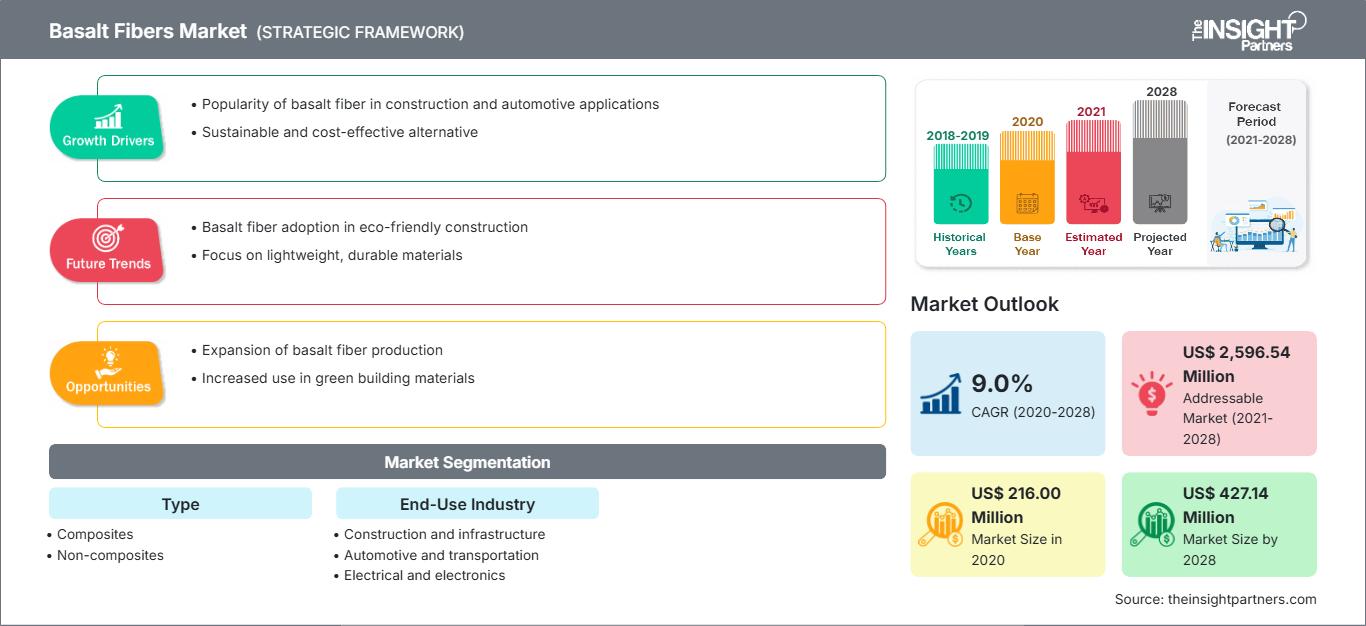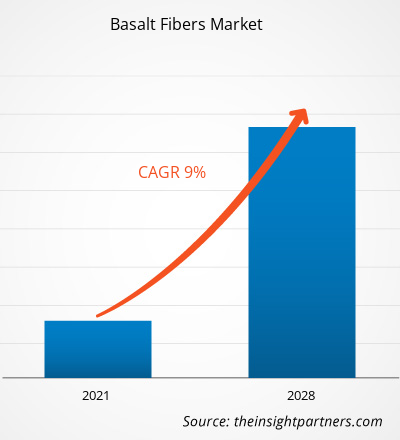Le marché des fibres de basalte était évalué à 216,00 millions de dollars américains en 2020 et devrait atteindre 427,14 millions de dollars américains d'ici 2028 ; il devrait enregistrer un TCAC de 9,0 % de 2021 à 2028.
Les fibres de basalte possèdent des propriétés chimiques similaires à celles des fibres de verre, mais ont de meilleures propriétés physico-chimiques que les fibres de verre. Le marché des fibres de basalte devrait connaître une forte croissance en raison de sa demande des industries d'utilisation finale telles que l'automobile, la marine, le bâtiment et la construction et l'électronique. L'augmentation des activités de construction dans plusieurs régions, due à la croissance démographique, à la hausse des revenus et aux initiatives gouvernementales dans diverses économies pour développer de meilleures infrastructures, est susceptible de stimuler la croissance du marché des fibres de basalte. Cependant, les propriétés variables des matières premières comptent parmi les facteurs freinant la croissance du marché des fibres de basalte.
En 2020, l'Asie-Pacifique représentait la plus grande part du marché mondial des fibres de basalte. Le continent Asie-Pacifique comprend plusieurs économies en développement et développées, telles que l'Inde, la Chine, le Japon, la Corée du Sud et l'Australie. Les pays émergents connaissent une forte croissance de l'industrialisation et de l'urbanisation. La croissance des projets de construction dans des pays comme l'Inde et la Chine et la croissance des investissements dans les infrastructures, comme la construction de nouvelles autoroutes, voies ferrées, lignes de métro souterraines et revêtements de chaussées, devraient stimuler le marché des fibres de basalte dans la région.
Personnalisez ce rapport en fonction de vos besoins
Vous bénéficierez d’une personnalisation sur n’importe quel rapport - gratuitement - y compris des parties de ce rapport, ou une analyse au niveau du pays, un pack de données Excel, ainsi que de profiter d’offres exceptionnelles et de réductions pour les start-ups et les universités
Marché des fibres de basalte: Perspectives stratégiques

- Obtenez les principales tendances clés du marché de ce rapport.Cet échantillon GRATUIT comprendra une analyse de données, allant des tendances du marché aux estimations et prévisions.
Vous bénéficierez d’une personnalisation sur n’importe quel rapport - gratuitement - y compris des parties de ce rapport, ou une analyse au niveau du pays, un pack de données Excel, ainsi que de profiter d’offres exceptionnelles et de réductions pour les start-ups et les universités
Marché des fibres de basalte: Perspectives stratégiques

- Obtenez les principales tendances clés du marché de ce rapport.Cet échantillon GRATUIT comprendra une analyse de données, allant des tendances du marché aux estimations et prévisions.
Impact de la pandémie de COVID-19 sur le marché des fibres de basalte
La pandémie actuelle a radicalement modifié le statut du secteur des produits chimiques et des matériaux et a eu un impact négatif sur la croissance du marché des fibres de basalte.
La mise en œuvre de mesures pour lutter contre la propagation du virus a eu un impact sur la croissance de plusieurs secteurs industriels. Des industries telles que la construction, l'automobile, la chimie et l'électronique ont été touchées par la distorsion soudaine de l'efficacité opérationnelle et les perturbations des chaînes de valeur attribuables à la fermeture soudaine des frontières nationales et internationales. Le déclin significatif de la croissance de plusieurs secteurs industriels a gravement affecté la demande de fibres de basalte sur le marché mondial. Cependant, alors que les économies prévoient de relancer leurs activités, la demande de fibres de basalte devrait augmenter à l'échelle mondiale. La demande croissante de fibres de basalte dans divers secteurs tels que la construction, l'automobile, la chimie, l'électronique et l'aérospatiale, ainsi que les investissements importants de fabricants de premier plan, devraient stimuler la croissance de ce secteur.
Aperçu du marché : De nombreuses applications des fibres de basalte dans diverses industries d'utilisation finale pour stimuler sa croissance
Les fibres de basalte ont un large champ d'applications dans divers secteurs d'utilisation finale, tels que la construction, l'automobile, l'électricité et l'électronique, la chimie, l'aérospatiale et la marine. Dans la construction, les brins de basalte coupés sont utilisés pour augmenter la résistance à la fissuration des panneaux de ciment. Grâce à leur stabilité chimique unique dans des conditions extrêmes, les fibres de basalte peuvent être utilisées dans de nombreuses structures en béton, telles que les ponts, les tunnels, les barrages et les planchers. Les fibres de basalte sont utilisées dans l'industrie chimique pour la production de tuyaux résistants aux produits chimiques, de revêtements de protection, de réservoirs de stockage de liquides corrosifs, d'engrais chimiques, d'acides, de substances toxiques, etc. L'application des fibres de basalte se développe et la demande du marché augmente à un rythme accéléré.Informations sur les produits
Le marché mondial des fibres de basalte est segmenté en fonction des produits : mèches, fils coupés, fils retors, tissus et rubans, entre autres. En 2020, le segment des mèches détenait la plus grande part du marché mondial des fibres de basalte. Les mèches de basalte sont un faisceau de fibres de basalte complexes unidirectionnelles continues. Elles résistent aux environnements agressifs, présentent une résistance naturelle élevée, une longue durée de vie et des propriétés d'isolation électrique supérieures. Grâce à leurs caractéristiques techniques, les mèches de basalte surpassent le verre E et le verre S à de nombreux égards. Français Le roving de basalte est extrêmement résistant à la chaleur et peut résister à des températures allant jusqu'à 1 000 °C pendant une courte période.
Kamenny Vek Company ; Fiberbas Construction and Building Technologies ; Hydro Design Management Co. Pvt. Ltd. ; Hg Gbf Basalt Fiber Co., Ltd ; Bastech ; Mafic SA ; Shanxi Basalt Fiber Technology Co. Ltd ; Technobasalt-Invest LLC ; Deutsche Basalt Faser Gmbh ; et Basalt Engineering LLC comptent parmi les principaux acteurs du marché mondial de la fibre de basalte.
Points forts du rapport
- Tendances progressives du secteur sur le marché de la fibre de basalte pour aider les acteurs à développer des stratégies efficaces à long terme
- Stratégies de croissance adoptées par les marchés développés et en développement
- Analyse quantitative du marché de la fibre de basalte de 2019 à 2028
- Estimation de la demande mondiale de fibre de basalte
- Analyse PEST pour illustrer l'efficacité des acheteurs et des fournisseurs opérant dans le secteur
- Évolutions récentes pour comprendre le scénario concurrentiel du marché
- Tendances et perspectives du marché ainsi que facteurs stimulant et freinant la croissance du marché de la fibre de basalte
- Aide à la prise de décision en mettant en évidence les stratégies de marché qui sous-tendent l'intérêt commercial, conduisant à la croissance du marché
- Taille du marché de la fibre de basalte à différents nœuds
- Aperçu détaillé et segmentation du marché, ainsi que la dynamique de l'industrie des fibres de basalte
- Taille du marché des fibres de basalte dans diverses régions avec des opportunités de croissance prometteuses
Aperçu régional du marché des fibres de basalte
Les tendances régionales et les facteurs influençant le marché des fibres de basalte tout au long de la période de prévision ont été détaillés par les analystes de The Insight Partners. Cette section aborde également les segments et la géographie du marché des fibres de basalte en Amérique du Nord, en Europe, en Asie-Pacifique, au Moyen-Orient et en Afrique, ainsi qu'en Amérique du Sud et en Amérique centrale.
Portée du rapport sur le marché des fibres de basalte
| Attribut de rapport | Détails |
|---|---|
| Taille du marché en 2020 | US$ 216.00 Million |
| Taille du marché par 2028 | US$ 427.14 Million |
| TCAC mondial (2020 - 2028) | 9.0% |
| Données historiques | 2018-2019 |
| Période de prévision | 2021-2028 |
| Segments couverts |
By Type
|
| Régions et pays couverts | Amérique du Nord
|
| Leaders du marché et profils d'entreprises clés |
|
Densité des acteurs du marché des fibres de basalte : comprendre son impact sur la dynamique commerciale
Le marché des fibres de basalte connaît une croissance rapide, portée par une demande croissante des utilisateurs finaux, due à des facteurs tels que l'évolution des préférences des consommateurs, les avancées technologiques et une meilleure connaissance des avantages du produit. Face à cette demande croissante, les entreprises élargissent leur offre, innovent pour répondre aux besoins des consommateurs et capitalisent sur les nouvelles tendances, ce qui alimente la croissance du marché.

- Obtenez le Marché des fibres de basalte Aperçu des principaux acteurs clés
- Analyse historique (2 ans), année de base, prévision (7 ans) avec TCAC
- Analyse PEST et SWOT
- Taille du marché Valeur / Volume - Mondial, Régional, Pays
- Industrie et paysage concurrentiel
- Ensemble de données Excel
Rapports récents
Rapports connexes
Témoignages
Raison d'acheter
- Prise de décision éclairée
- Compréhension de la dynamique du marché
- Analyse concurrentielle
- Connaissances clients
- Prévisions de marché
- Atténuation des risques
- Planification stratégique
- Justification des investissements
- Identification des marchés émergents
- Amélioration des stratégies marketing
- Amélioration de l'efficacité opérationnelle
- Alignement sur les tendances réglementaires






















 Obtenez un échantillon gratuit pour - Marché des fibres de basalte
Obtenez un échantillon gratuit pour - Marché des fibres de basalte